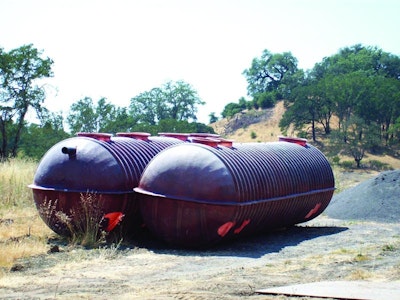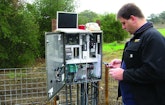
Interested in Pumps?
Get Pumps articles, news and videos right in your inbox! Sign up now.
Pumps + Get AlertsIt was a relatively straightforward job, but the land posed challenges. Jordan Vineyard & Winery in Sonoma County, Calif., wanted to redo its wastewater system. Since 1976 the business had operated a combined domestic and process wastewater system, and now it needed an upgrade. The cause was two-part. One part was the age of its original package plant. The other part was the advantage of water reuse.
The package plant was simply at the end of its life, illustrated by the rust streaks on its exterior. “I was in a meeting with the county regulators one day, and the facilities manager said, ‘I’m tired of sending my welders down there in breathing gear to patch the holes in that package plant,’ ” says Pete Lescure of Lescure Engineers in Sonoma County. He designed the solution for Jordan.
Then there was water reuse. From the beginning, Jordan had been sending process wastewater from its winemaking operation into a pair of ponds a short way down the hill behind the winery building. The package plant discharged its water into the ponds also, but with both types of wastewater mixing there, the winery could not employ that water to irrigate grapevines. With the wastewater flows separated and an upgraded aeration system in the pond, that water is now used for both grapevines and landscaping around the winery building.
TWO STREAMS
Separating the waste streams was easy. A new 1,200-gallon grease interceptor reduced BOD loads from the kitchen and restaurant. Wastewater from kitchen and washrooms was collected in a 6-inch pipe and sent down the hill to a pair of Fiber Enterprises 10,000-gallon tanks buried next to the existing ponds. The first of those two tanks functions as a septic tank to provide initial treatment. From this tank, water flows into the second, which serves only as an equalization tank for flows that can range from 500 to 6,000 gpd, depending on how many people the winery entertains.
The 10,000-gallon tank will store the total volume from the highest historical three-day flows, while dispensing only 3,500 gpd to treatment and dispersal. This illustrates the value of keeping good records for a commercial facility, otherwise they would have pumped effluent to a second field even further away, Lescure says. Water had to flow out of the equalization tank for secondary treatment, and this is where the project became complicated.
In some states, in the East or Midwest for example, there are only two or a few types of soil, Lescure says. California isn’t like that. “The soils in California are quite varied. We’ve got a lot of volcanics and uplifted marine sediments in Sonoma County. They’ve got about 700 acres at Jordan, and I swear we explored a couple hundred of them. I had a technician out there for a week digging with a backhoe.”
The search for suitable soil began on slopes near the 10,000-gallon tanks and expanded, and expanded, and expanded. At first it looked as if the soil near the building was usable, but that appearance was deceiving because of how vineyards are planted, Lescure says. Before putting in the grapevines, vintners run a tractor across the land with a ripper blade to break up the soil. That can lead you to believe the water will percolate when it is really a jumble of clay and rock, good for vines and full-flavored wines, but not suitable for a wastewater soil absorption field.
A DISPERSAL SITE
When the initial exploration produced no good site, Lescure took a look himself and realized the problem was the hard pan. Then he saw a hillside covered with oak trees, and he knew the search was over because the presence of oaks indicated the presence of good soil. Technicians found a good loam, but it was about 2,500 feet away from the 10,000-gallon tanks near the building. The answer was a force main using 2-inch schedule 40 PVC.
The main cuts through some of the vineyard’s grapevines, but there was little risk to the plantings because the vine irrigation system deposits water right next to the plant stems. Water trickles straight down, and this draws the roots deep and discourages them from spreading.
The force main ends in a Fiber Enterprises 8,000-gallon tank divided in half with a baffle. The 4,000-gallon segment into which the main discharges is used to dose four Orenco Systems AdvanTex AX-100 units. Each unit is dosed in sequence through a distribution valve. This smaller flow allows the use of smaller pumps, Lescure says. The AdvanTex units are also connected to a large fan that blows extra air into the pods so bacteria have plenty of oxygen for digesting waste.
Water returning from the AdvanTex units is divided. The larger fraction, 80 percent, is recirculated through the 4,000-gallon dosing chamber for the AdvanTex pods. The remaining 20 percent is sent into the other 4,000-gallon half of the tank. From here water is channeled into 6,708 linear feet of Geoflow drip tubing. This also is split into four zones, and a valve controls the dosing. The drip field can take up to 3,500 gpd.
DRIP TUBE PLAYS ROLE
Drip tubing was advantageous. Slopes on the irrigation field varied from 15 to 40 percent, and drip irrigation can be used on land up to about a 50 percent slope, Lescure says. Another advantage was that drip tubing can be installed with a small trencher, which meant minimum disturbance to the roots of the large oaks.
County regulations required an area for 15,598 linear feet of dripline be available as a reserve, but it has not been installed, and Lescure is sure it never will be. “I don’t think these lines will ever fail because they’re receiving a much higher quality effluent, and they’re not fed by gravity, so the soil never really gets saturated. And you’re up in the active biological zone.”
Another reason the driplines remain clean is the back-flush cycle. After a set number of doses, the flow is reversed to push any accumulated solids back into the recirculation chamber. There is enough latent storage capacity in the tanks to do this, Lescure says.
In addition to the force main, workers had to lay a phone line next to it. The duplex Hydromatic SHEF 100 pumps in the 10,000-gallon equalization tank and duplex AdvanTex AX100 pumps in the 8,000-gallon dosing tank are controlled by Orenco panels, but the panels communicate with each other. If there is some malfunction in the dosing tank, its panel can command the panel at the equalization tank to cease sending water through the force main. The phone line also allows the panels to call the winery and alert its office staff that there is a problem in the wastewater system.
21ST CENTURY SYSTEM
Although the panels can sound an alarm, the system is designed to provide as few problems as possible so winery workers can focus on their primary job. To achieve this Lescure specified duplex pumps in the tanks so the winery business will not be brought to a halt by the failure of a single critical component in the wastewater system.
The only loss caused by the installation was some olive trees that were in the way of the drip irrigation. Fortunately, olive trees are valuable and transplant easily, Lescure says. The winery held a tree sale, and that was the end of that.
After close to 40 years with old technology, Jordan Vineyard & Winery is now pursuing its time-honored craft with a modern wastewater system that cleans its blackwater and frees it to reuse the graywater. For this business in thirsty California, best-available technology expanded the available water supply without pulling a single additional drop from reservoirs or aquifers.
MORE INFORMATION
Fiber Enterprises, Inc. - 530/527-2196 - www.fiberenterprises.com
Geoflow, Inc. - 800/828-3388 - www.geoflow.com
Orenco Systems, Inc. - 800/348-9843 - www.orenco.com
Pentair Water - Hydromatic - 888/416-9513 - www.hydromatic.com









